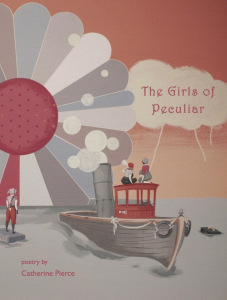
|
So many books about girls begin in the realm of legwarmers and end in a flimsy ether of rhetoric. Too many collections of poems that aspire to crystallize a formative experience instead push the reader to the other side of the candy counter or slam the car door before the guitar solo reaches its apex. The Girls of Peculiar by Catherine Pierce succumbs to none of these pitfalls. Rather than providing a superficial definition of what it means to be a girl, this collection provides a deeply interior and profoundly felt view of our changing relationship with the world beyond our recollections. What is especially remarkable about the stories Pierce tells is how she allows them to begin and end in the body. In “Train Safety Assembly,” the speaker recalls a cautionary film: “I carried the movie like a door / behind my ribs. Sometimes / it swung into a starless black.” Here we have a delightfully objective disengagement from the past, a replacement of yesteryear’s hysteria with cool-eyed curiosity. The image of an oncoming train becomes a challenge, a talisman of unfortunate meaning, and yet remains worthy of admiration in its unflinching steeliness. “The train is simply / the opposite of what I want my life to be,” Pierce writes. “On the other hand, it never flinches.” The film plays within the body, just not in its intended form. A train always heads somewhere else, and its refusal to flinch testifies to mechanical limitations, not necessarily resilience. Perhaps this unflinching quality allows the objects that populate the landscape of The Girls of Peculiar to radiate with a glow that is at once resplendent and suspicious. The artifacts of this collection occupy worlds of incorruptibility or foreboding. Throughout the book hovers the presence of girls in the plural, from the opening “Poem to the Girls We Were,” which delivers a sensory portrait of the past twinned with collective imperatives regarding the present, to “Desire: Three Girls,” which transcends time, place, and geography, even while those three elements serve as organizational guideposts for the poem. Far from dissolving her speakers into a diffuse “everygirl,” or conflating entire generations of young womankind, Pierce allows her characters to be at once universal and peculiar. These peculiarities are not carnivalesque or sensational, but rather familiar estrangements: girl versus society, girl versus the domestic pastoral, girl versus fear, girl versus previous versions of herself. Pierce has succeeded in cultivating multiple arcs in this collection, while also allowing backstories to brew. The 1970s serve as friendly specter, an almost-forgotten era of dark eyeliner and innocent longing. The idea of the future looms in various incarnations, from the dogmatic humor of “The Guidance Counselor to the Girl,” to “A Catalogue of My Wants from Age 16 to the Present,” which is anything but a conventional wish list. Divided into four sections, “The early part,” “Later,” “Later still,” and “Now,” this poem is a lesson in variation and resonance: Later: For my insides to match the rocking quiet. Absent from this list, and others in the poem, is a sense of transient materiality. The desire here is for experience and sensation, particularly in an enduring sense. More than a desire for spectacle, or a wish for typical adornments, the speaker here seeks a power derived by movement. Even the final section, “Now,” sends the reader off with a push: “To disappear, whooping. / To fall asleep, enviably twirling. To be / a flying dream. To live inside every word.” The Girls of Peculiar is a departure from much of the contemporary writing that chronicles the female coming-of-age experience. Pierce prefers luminescence over sentimentality, and is not afraid to make the reader as uneasy as a heroine navigating through unfamiliar terrain. These poems dazzle in their variety and sharpness. The eye of an oncoming train may be unblinking, but these poems are strong enough to divert even the heaviest subjects off their tracks. --Mary Biddinger Mary Biddinger's most recent poetry collection is A Sunny Place with Adequate Water (Black Lawrence Press, 2014). She is co-editor-in-chief of Barn Owl Review, and editor of the Akron Series in Poetry. |
|
